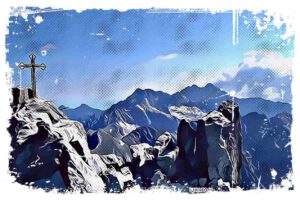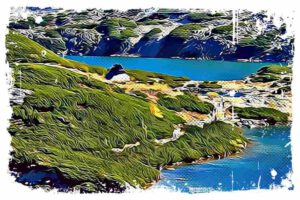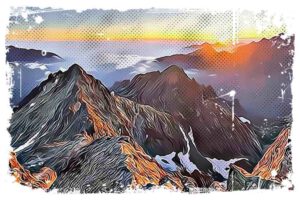These buildings will definitely grab your attention, whether it’s through surprise, shock, delight, or embarrassment. I can say this from my own experience, as I saw most of them myself – you won’t be able to pass them by indifferently.
I would like to share with you my subjective review of the strangest buildings in Poland. You don’t have to travel to the end of the world to see unconventional architecture.
Even in Poland, there are plenty of unique buildings to explore. I’ve rounded up some of the most interesting and peculiar structures you’ll find scattered across the country.
By the way, please check my other article about abandoned palaces in Poland. You will learn more about these strange buildings in our country.
↳ Before you head to Tatra Park, I highly recommend reading my complete guide to Tatra Mountains. I showcase the most scenic places you won't want to miss. Make sure to check it out, so you don't overlook anything interesting: Tatra Mountains – An Insider’s Guide to All Attractions and Info
Tatra Mountains Witch House
These are not the typical Highland houses that you can often see in Zakopane and in the villages around it. Instead, they represent a new trend. This trend is spreading not only in Podhale, but also in other regions of Poland. More and more people in the Highlands are opting for houses with a unique shape, the most surprising element of which is the wavy, soft roof.
The designer of the house, Sebastian Pitoń, claims that similar shapes were used by Witkiewicz in the past. He sees it as a continuity of stylistic development. The organic shapes and sophisticated ornamentation he adds to his buildings are nothing new. Pitoń feels that he is contributing to the development of the Podhale style by drawing heavily on traditions.

Houses with soft roofs, which can already be seen in Bukowina Tatrzańska, Kościelisko and Gliczarów, are mostly ordered by people from Poland.
The Crooked House in Sopot
I have personally seen the Crooked House in Sopot’s „Monciak”. It was built in 2003 and has since become one of the most recognizable landmarks of the city. It is impossible to pass by without noticing the unusual facade of the building, which does not have any rectilinear elements.
The wavy lines of the cornices, the smooth walls, and the slanting window openings remind me of Jan Szancer’s fairy tale drawings or surreal hallucinations.

It’s hard to judge the Crooked House strictly from an architectural perspective. Had it been built a decade earlier, it would have been a great example of postmodern experimentation with form. But it seems like an outdated architectural joke, built at the turn of the 21st century.
When you visit Sopot, do not miss the greatest parties: Where to Party in Sopot: The Best Clubs and Bars
Upside-Down House in Szymbark
As I saw it firsthand, I can say that the Upside-Down House in the Center for Education and Regional Promotion in Szymbark looks like a typical gabled wooden house, but with a twist. The owner and creator of the house decided to turn it upside down.
The roof is buried one meter into the ground. There are pipes and cables protruding from the foundation fragments dug out of the ground, giving the impression of a scene from a post-apocalyptic world.

The intention of the creator of this unconventional project is for the upside-down house to be not only a tourist attraction, but also a monument to the subversion of values and the collapse of the communist system.
Gesi Zakret in Zadworze
When I arrived at Gęsi Zakręt, I couldn’t help but exclaim „Wow!” in amazement, my voice echoing in the uniquely furnished house. Ania rushed past me and told me to make myself at home.
Outside, I met Paweł, who was finishing preparations for a weekend rally on his bike. The atmosphere was positive and it was obvious that I had entered the daily life of Ania and Paweł, who had left the rat race for the peace of the Bieszczady Mountains.

Gęsi Zakręt is a brilliantly designed house with a large common area downstairs and cozy rooms upstairs. Through the large windows you can admire the beautiful nature. Although the house may seem small at first, it will grow on you as you explore its creative design. There is plenty of space outside to relax and enjoy the outdoors, perhaps even on a sun lounger.
Gęsi Zakręt is the perfect place if you’re looking for unique accommodation in the Bieszczady Mountains and want to explore both the popular and lesser-known regions. Compared to the bustling towns of Wetlina or Cisna, the atmosphere is definitely quieter and more peaceful.
Rajcula Inn in Paniowki
It’s always a pleasure for me to discover a restaurant that offers traditional cuisine in a cozy and charming atmosphere.
Rajcula Paniówki, with its old Polish inn style and surrounding wooden figurines and pond, seems to fit the bill. With an impressive number of seats and a reputation for delicious food, it’s no surprise that the restaurant is popular and often packed on weekends.

Despite the crowds, service at Rajcula Paniówki is quick, a testament to the hard-working and efficient staff. Regarding the meaning of the name Rajcula, it’s interesting to learn that it refers to a smart and cheeky girl, which could be a reference to the lively and friendly atmosphere of the restaurant.
All in all, Rajcula Paniówki sounds like a great choice for a Sunday family dinner or any occasion when you’re looking for tasty, traditional Polish cuisine in a cozy and welcoming setting.
What’s interesting is how restaurants like Rajcula succeed in balancing traditional Polish food with modern influences. It’s proof of the versatility of Polish food and the creativity of the cooks.
Even the standard side dishes like fries have become a common part of Polish menus. It just goes to show how food and culinary culture are constantly evolving and adapting to changing tastes and trends.
Overall, it is a great place to experience traditional Polish cuisine in a cozy and inviting atmosphere.
Gargamelowka in Zakopane
When one of these unconventional highland houses was built on Kościeliska Street, the locals mockingly called it „Gargamelówka”.
While some argue that this house is no longer in the Highlander style, but rather something completely new in architecture, others feel that it draws heavily on traditional Highlander construction. The owner believes that this house has little in common with a highlander’s house.
If you ever decide to visit Zakopane, You should definitely read this article: Unbelievable Story Behind Giewont Peak’s Cross: Zakopane’s Tatra Icon. It’s a great story about a deadly steel cross intstalled on a mountain’s peek.

The building has caused some controversy among locals, who argue that its design is not in keeping with the traditional architecture of the area.
In response to the criticism, the developer has stated that the design is intended to be a modern interpretation of Highlander architecture, but this has not quelled the concerns of many in the community. It remains to be seen if the construction will be completed as planned or if there will be further changes to the design.
Bibliography
- https://www.bryla.pl/bryla/56,85301,10381215,Bardzo_nietypowe_budynki_z_Polski__Wprawiaja_w_zachwyt.html
- https://gesizakret.pl/
- https://www.rajcula.pl/




